Infrastructure
India Is Now World’s No. 2 Rail Freight Power: How The Dedicated Freight Corridors Delivered
Ankit Saxena
Oct 16, 2025, 03:08 PM | Updated Nov 03, 2025, 03:37 PM IST
Save & read from anywhere!
Bookmark stories for easy access on any device or the Swarajya app.
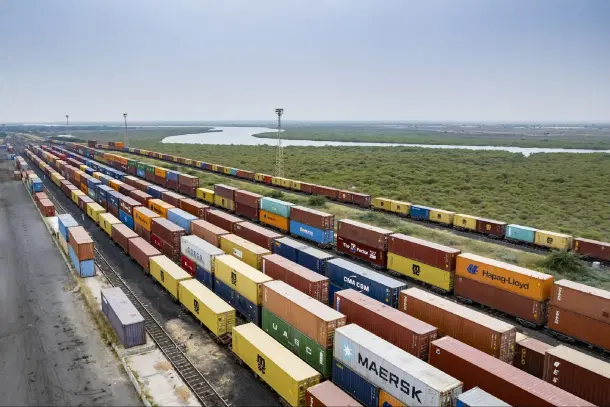
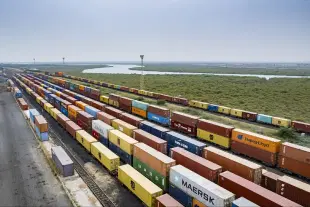
The global rail freight statistics for the financial year 2024–25 indicated a major shift, with Indian Railways emerging as the world’s second-largest rail freight carrier.
By transporting 1,600 million metric tonnes (1.6 billion tonnes, BMT) of goods, India surpassed the United States and Russia, positioning itself just behind China in global rail freight rankings.
For comparison, China transported roughly 4,000 million metric tonnes (4.0 BMT), while the United States transported 1,500 million metric tonnes (1.5 BMT) and Russia handled 1,100 million metric tonnes (1.1 BMT) over the same period.
In the previous year, Indian Railways transported nearly 1,460 million metric tonnes of freight, closely trailing the United States, which moved around 1,760 million metric tonnes.
Several factors have driven India’s rapid rise in rail freight, with the operationalisation of Dedicated Freight Corridors (DFCs) playing a central role.
This progress has been further supported by increased freight wagon production, which has expanded the network’s carrying capacity, and by infrastructure initiatives such as government-approved multi-tracking projects to add hundreds of kilometres of new tracks.
India’s Dedicated Freight Corridor
Indian Railways has successfully operationalised over 96 per cent of its Dedicated Freight Corridors (DFCs), which cover a distance of more than 2,800 kilometres.
These electric broad-gauge corridors are designed exclusively for freight trains, significantly improving both speed and operational efficiency in India’s rail freight network.
The DFC network includes two corridors: the Eastern Dedicated Freight Corridor (EDFC), stretching 1,337 km and running between Ludhiana in Punjab and Sonnagar in Bihar, and the Western Dedicated Freight Corridor (WDFC), 1,506 km long, running between the Jawaharlal Nehru Port Terminal (JNPT) in Mumbai and Dadri in Uttar Pradesh.
When the Dedicated Freight Corridor (DFC) project was initiated under the Tenth Five-Year Plan (2002–07), freight traffic was projected to increase from 489 million tonnes in 2001–02 to 624 million tonnes by 2006–07, reflecting an annual growth rate of about 5 per cent.
However, despite the project’s formal approval in 2006, progress in translating the plan into on-ground development remained slow. By March 2014, only a small portion of the contracts for both the Western and Eastern DFCs had been awarded.
As the DFC represents a strategic effort to modernise India’s freight infrastructure and align it with projected rail traffic growth, only in the past decade has a major push been witnessed in the development of corridors.
This period of steady progress culminated in the commissioning of the first freight corridors in 2019–20. By February 2024, the Eastern Dedicated Freight Corridor (EDFC) had been fully completed.
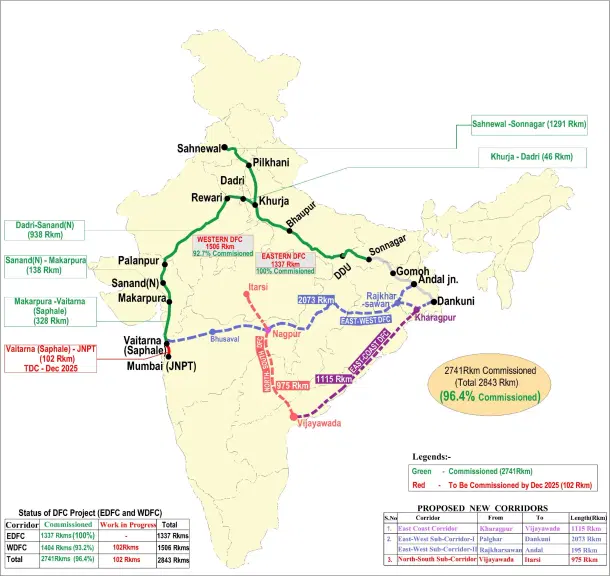
Compared with other countries, China operates over 4,000 km of freight corridors within a rail network of approximately 162,000 km. These corridors primarily serve heavy-haul coal trains, double-stack container traffic, and electrified mixed-use lines.
The United States, despite having the world’s largest rail network of over 220,000 km, does not operate exclusive freight corridors. The network is largely mixed traffic, though heavily optimised for freight operations. Similarly, Russia’s rail network spans 105,000 km, with the Trans-Siberian Railway serving as a mixed-use mainline over approximately 9,289 km.
Measuring the Expansion of India’s Freight Corridor
By 2014–15, around 30 km of the corridor had been constructed, including the track connecting New Karwandiya and Durgawati on the Eastern DFC, along with initial bridge work on the Western DFC.
Here is the progress of the corridor’s expansion, tracing the journey from the survey and contract stages in 2014 to the near-completion of the freight corridors by 2025, is based on Dedicated Freight Corridor Corporation of India Limited (DFCCIL) annual reports and data from 2014 to 2025.
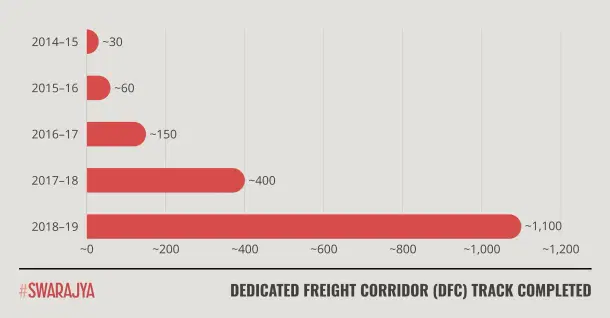
In 2015–16, progress on land acquisition reached 96 per cent, clearing the way for civil works and early contracts to begin.
The next two years saw accelerated construction, with tracks being laid across important stretches such as Khurja–Bhaupur and Rewari–Phulera.
By 2017–18, most of the major contracts for both corridors were awarded, and work on signalling and system installations had begun. By 2018–19, with nearly 1,100 km of the network completed, several sections began trial runs.
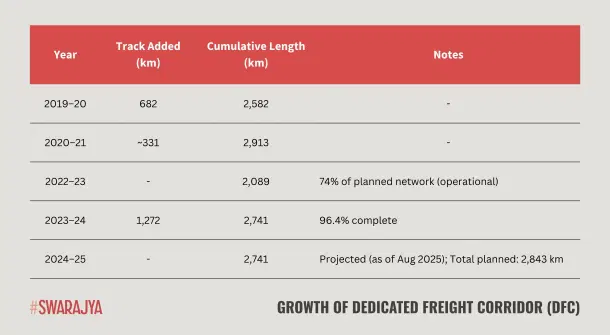
In 2019–20, the Rewari–Madar section of the WDFC and the Bhadan–Khurja section of the EDFC were completed. Commissioning began with the Rewari–Palanpur and Bhaupur–Khurja sections.
Between 2021 and 2023, the network continued to expand, with commissioning extended to several major sections, achieving approximately 74 per cent network completion and handling over 62,000 freight trains during that period.
Recent data as of August 2025 show that 2,741 km out of the total 2,843 km of the corridor is operational, with the EDFC fully commissioned and 93 per cent of the WDFC complete.
The remaining 102 km on the Western corridor, connecting Vaitarna to Jawaharlal Nehru Port Trust (JNPT), are expected to be fully commissioned by the end of 2025.
DFC Showing Results
These corridors now handle around 300 to 325 freight trains daily, marking a 60 per cent increase in train operations compared with the pre-DFC period.
Moreover, the average speeds of goods trains on the DFCs range between 50 and 60 km/h, with the potential to reach up to 100 km/h. This is substantially higher than conventional mixed-traffic lines, where average speeds typically hover around 20–25 km/h.
Before the era of dedicated freight corridors, Indian Railways experienced steady but modest growth in freight volumes.
Between 2010 and 2018, annual freight loading increased from approximately 888 million tonnes to 1,160 million tonnes, with an average growth rate of 3–5 per cent per year.
This growth was limited by infrastructure constraints such as congestion, slow speeds, and capacity bottlenecks.
The scenario changed significantly after 2019 with the gradual commissioning of the Eastern and Western Dedicated Freight Corridors. Between 2019 and 2025, freight volumes grew with the support of increased capacity, speed, and reliability provided by the DFCs.
Freight loading rose from 1,221 million tonnes in 2019 to an estimated 1,617 million tonnes in 2025, with annual growth rates exceeding 5 per cent in most years and peaking at around 8 per cent in 2021 and 2023.
In 2020–21, during the COVID-affected period, freight loading stood at 1,233 million tonnes. This increased to 1,418 million tonnes in 2021–22.
The upward trend continued with 1,512 million tonnes loaded in 2022–23, followed by 1,591 million tonnes in 2023–24. These gains coincided with the commissioning of key DFC sections, allowing for heavier and faster trains to operate on tracks solely for freight.
Moreover, the DFCs have promoted a modal shift from road to rail, regaining market share lost over previous decades. By FY 2024–25, the DFCC was operating more than 325 trains daily, a 60 per cent increase over the previous year.
The EDFC has been extensively utilised to ensure timely delivery of thermal coal to power plants. According to DFCCIL, more than 10 per cent of the national transporter’s freight volumes are now being handled by the corridor.
The infrastructure investment benefitted not only high-growth industrial centres but also less-developed regions by improving accessibility and lowering transport expenses.




